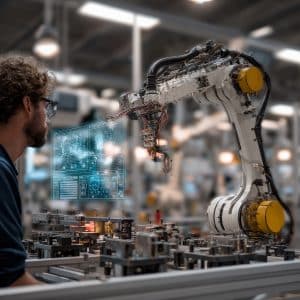AI and the Rise of the Smart Factory
Research Article

AI and the Rise of the Smart Factory are topics that industry leaders have been collectively discussing with no true resolve. In the past “smart” often meant a patchwork of connected systems: sensors here, dashboards there, and a few predictive models sprinkled across the shop floor. AI is changing that. We’re entering a new industrial era where AI doesn’t just monitor factories, it runs them.
The shift is from connected operations to fully integrated, autonomous production environments. And the organizations that succeed won’t be the ones chasing every shiny new tool, but those that know how to embed AI into the fabric of daily operations. That embedding starts with clarity, value stream mapping becomes essential, revealing where data flows, where decisions stall, and where AI can unlock compounding efficiencies. It’s not just about automation; it’s about architecting intelligence across every step of production.
Introduction
We’re entering a new industrial era where AI doesn’t just monitor factories, it runs them. The shift is from connected operations to fully integrated, autonomous production environments. And the organizations that succeed won’t be the ones chasing every shiny new tool, but those that know how to embed AI into the fabric of daily operations.

Real-Time Decision Making
Edge AI enables instant responses to production anomalies. When sensors detect deviations in temperature, pressure, or quality, AI systems can adjust processes immediately, no waiting for cloud analysis or human escalation. This capability doesn’t replace human judgment; it mobilizes it. By embedding baseline decision-making logic into edge systems, AI empowers teams to act faster, with greater precision. The result is a more responsive, agile environment where frontline operators and managers can focus on strategic interventions while routine decisions are executed autonomously and in real time.
Intelligent Resource Allocation
From machines to materials, energy to labor, AI optimizes the use of every resource across multiple production lines simultaneously. It continuously balances workloads, minimizes idle time, and reduces energy consumption while maximizing output. But this shift isn’t about replacing people, it’s about reimagining roles. Smart factories create opportunities to reskill and upskill the workforce, aligning talent with higher-value tasks and strategic oversight. When AI handles the routine, human potential is freed to drive innovation, collaboration, and continuous improvement across the value stream.
Autonomous Production Systems
AI orchestrates entire production lines with minimal human intervention, dynamically adjusting workflows, rerouting materials around bottlenecks, and optimizing schedules in real time based on demand, materials, and equipment status. In China, some factories now operate in “dark mode,” fully autonomous, lights-out environments that run 24/7 to maximize throughput and reduce labor dependency. These facilities showcase the future of industrial scalability, where AI not only drives efficiency but redefines the boundaries of human-machine collaboration.
Real-Time Decision Making
Edge AI enables instant responses to production anomalies. When sensors detect deviations in temperature, pressure, or quality, AI systems can adjust processes immediately, no waiting for cloud analysis or human escalation. This capability doesn’t replace human judgment; it mobilizes it. By embedding baseline decision-making logic into edge systems, AI empowers teams to act faster, with greater precision. The result is a more responsive, agile environment where frontline operators and managers can focus on strategic interventions while routine decisions are executed autonomously and in real time.
Adaptive Quality Systems
Quality control is no longer reactive. AI predicts defects before they occur and automatically adjusts processes to prevent them. These systems learn from each product manufactured, continuously refining standards over time. Within smart factory environments, traditional quality methodologies like Kaizen, Six Sigma, and SPC are not discarded, they’re amplified. AI brings these systems to life by enabling immediate, data-driven action at the point of need. Through the AMS REAL framework, these interventions are not only fast and precise, but also ethically aligned, ensuring that every corrective measure supports transparency, accountability, and continuous improvement.
Self-Optimizing Supply Chains
AI-driven platforms integrate procurement, production, and delivery. They automatically adjust schedules based on demand signals and supply chain disruptions, making factories more resilient to global shocks. This continuous recalibration enables optimized operations across the entire value chain. Inventory levels are dynamically managed, supplier relationships are prioritized based on performance and risk, and logistics are rerouted in real time to avoid delays. The result is a supply network that’s not just reactive, but anticipatory, capable of maintaining flow, reducing waste, and maximizing throughput even under volatile conditions. Smart factories thrive when supply chains think ahead.
Digital Factory Twins
Comprehensive virtual models simulate entire factory operations, letting managers test new processes, predict impacts, and optimize layouts before making physical changes. AI keeps these digital twins learning and evolving in sync with reality. This creates a living mirror of the factory, one that continuously ingests data, refines assumptions, and enables scenario planning at scale. From energy usage to throughput bottlenecks, every variable can be modeled and stress-tested before execution. The result is faster innovation cycles, reduced downtime, and smarter capital investment. Digital twins also serve as a collaboration hub, aligning engineering, operations, and leadership around a shared, data-driven view of performance and potential.
Human-AI Collaboration
AI isn’t here to replace people; it’s here to augment them. Workers gain real-time insights, predictive alerts, and optimization suggestions, while AI handles the routine decisions autonomously. The result is a workforce that’s more empowered, not less. This convergence of human expertise and machine intelligence is where modern organizations unlock exponential value. By aligning roles with AI-enabled workflows, companies can reskill and redeploy talent toward higher-impact functions. It’s at this intersection, where intuitive tools meet human judgment, that productivity accelerates, innovation flourishes, and strategic agility becomes a lived reality.
The Key to Success
The real breakthrough isn’t in any single application. It’s in integrating them into a cohesive ecosystem where data flows seamlessly between systems, enabling factory-wide intelligence and autonomous decision-making. That’s the difference between having “AI tools” and having a truly AI-enabled factory. Success lies in orchestrating these capabilities through a unified architecture, one that connects digital twins, edge analytics, adaptive quality systems, and human-AI collaboration into a living, responsive network. AMS’s REAL framework ensures this integration is not only technically sound but ethically grounded, aligning innovation with transparency, accountability, and long-term value creation.
Join the ranks of leading organizations that have partnered with AMS to drive innovation, improve performance, and achieve sustainable success. Let’s transform together, your journey to excellence starts here.
